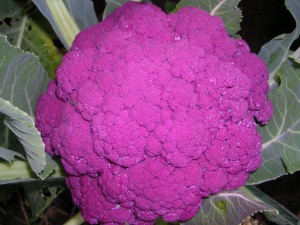Learn how to grow cauliflower including information on varieties.
Listen to podcast:
I love the taste of cauliflower (Brassica oleracea), but now I love the look of it, too. I grew a purple-headed variety, ‘Graffiti’ a few years ago and the neon colors in the garden blew me away. There are now green and orange colored varieties as well.
 What used to be a boring, white, cool season vegetable, has gotten a fashion overhaul. The colors also mean a nuttier flavor and higher nutrition. Serve cauliflower raw in salads. I like to steam it with other vegetables. Unfortunately, the purple varieties lose their luster when cooked, but not the orange or green varieties.
What used to be a boring, white, cool season vegetable, has gotten a fashion overhaul. The colors also mean a nuttier flavor and higher nutrition. Serve cauliflower raw in salads. I like to steam it with other vegetables. Unfortunately, the purple varieties lose their luster when cooked, but not the orange or green varieties.
When to Plant
Cauliflower, like all cabbage family plants, mature best under cool spring or fall conditions with temperatures under 70F. Knowing that our springs can be very short and heat up quickly, I’ve found that growing cauliflower as a fall crop more successful.
Sow seeds in the summer garden 90 days before the first frost for a fall crop. Look for spots where spring vegetables, such as peas and spinach, have finished producing. Yank out those crops and plant some cauliflower. For an early summer crop, purchase and transplant seedlings from the garden center 3 weeks before your last frost.
Where to Plant
Cauliflower grows best in full sun and on well drained, fertile soil. Like cabbage, planting quick maturing crops of radishes, mesclun mix, and lettuce around newly planted cauliflower allows you to harvest these crops before the cauliflower gets too large to shade it out.
How to Plant
Cauliflower loves lots of fertility so, amend the soil well with compost before planting. Sow the small seeds, or transplant seedlings, 18- to 24-inches apart in rows spaced 3-feet apart.
Care and Maintenance
Cauliflower needs a consistently moist soil and good fertility to form large heads. Add a small handful of organic fertilizer, such as 5-5-5 monthly, to stimulate good growth. Keep the soil moist with regular weeding and mulching established plants with a layer of organic mulch such as straw or untreated grass clippings. When pulling weeds or hoeing be careful not to damage the shallow roots.
Older varieties of cauliflower need to be blanched (block the sunlight) by placing a bag over the developing head or wrapping the leaves together, to get a pure white color. If not blanched the heads develop a strong flavor. Newer varieties are called self-blanching, meaning the leaves automatically grow over the head and blanch it. Colored varieties don’t require blanching.
Cauliflower is plagued with similar problems as other cabbage-family plants. Seedlings may fall victim to cutworms in spring. Protect transplants by wrapping a 3-inch-thick strip of newspaper around the stem, keeping it 2 inches above the ground and 1 inch below. Cabbageworms and cabbage loopers are common pests, but less of a problem on fall planted cauliflower. Check for green worms eating the leaves and spray an organic pesticide containing Bacillus thuriengensis (Bt) on plants to control them. Grow disease resistant varieties and rotate crops to avoid fusarium wilt and black rot.
Harvest
Pick heads when they are about 6- to 8-inches in diameter, but before curds (small flower buds) have started to separate and have a rice-like appearance. Most varieties mature in about 60 days. With a sharp knife cut under the head. Remove the plants because they’re unlikely to sprout another cauliflower.
Additional Information
The best white cauliflower varieties to grow are the self-blanching, ‘Fremont Hybrid’ and ‘Cassius Hybrid’. ‘Cheddar;’ is an orange colored variety loaded with beta-carotene. ‘Graffiti’ is a purple colored variety and ‘Panther’ is a green colored variety. For something really wild try ‘Veronica’. This green-colored cauliflower is a Romanesco-type, meaning it has small spires on its head. It looks like it’s from another world.
Text excepted from the Northeast Vegetable and Fruit Gardening book.
Podcast Transcript
This vegetable was once the rage at the court of Louis the 14th. It was made famous when Mark Twain called it a cabbage with a college education. Yes, it’s the cauliflower. But before you go ho-hum over white cauliflower, let’s look at how its changed. Through breeding there are purple headed varieties, such as “Graffiti,” orange headed varieties, such as “Cheddar” and green headed varieties, such as “Panther.” My favorite is the Romanesco cauliflower that features green heads with swirling spirals. These colorful selections contain more vitamins and nutrients than white varieties. So yes, cauliflower not only has a college education, it has as Master’s degree.
The key to growing cauliflower in our climate is timing. Cauliflower is much less tolerant of hot weather than its cousins broccoli, cabbage and kale. That’s why I grow it as a fall crop. Cauliflower grows great maturing from September to November. Here’s how to grow it. Start seeds now indoors. Transplant them into the garden by the end of July into compost amended soil. Keep the young plants protected from flea beetles, cabbageworms, and other insects with a floating row cover and keep them well watered. Come mid August with our cooler nights, cauliflower will take off. The large plants need a good 2 foot spacing to grow and the leaves are edible as well as the heads so consider pruning off a few for stir fries. Most white varieties are now self blanching meaning the leaves naturally cover the head to keep it white. Start harvesting as soon as the heads are large enough to eat, but before the curds (small flowers) get a rice-like appearance.


